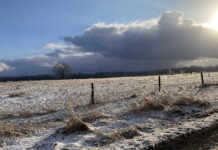As I began to write this article on “Hay There,” it occurred to me there was a song with a similar title and so I searched for it.
The song Hey There Delilah was released in 2006 by the group Plain White T’s. It was written by Tom Higgenson after he met Delilah DiCrescenzo, a well-known runner. It is written about all the pitfalls of a long-distance love relationship. One of the stanzas has these lyrics:
Hey there Delilah
I know times are getting hard
But just believe me, girl
Someday I’ll pay the bills with this guitar
We’ll have it good
We’ll have the life we knew we would
My word is good
I couldn’t help but share this here with the hard times in the dairy industry and the thoughts that often resonates of “someday I’ll pay the bills,” “we’ll have it good,” “my word is good.”
Well, “hay there,” now that I have your attention by some song lyrics that really have nothing to do with this article, let’s move on.
Uncertainty
Alfalfa stands to have experienced a lot of loss from the weather conditions of 2019 which challenged forage availability in 2019 and, in some places, now in 2020. First cutting this year was reasonably well in most areas in terms of yield and quality. However, with the limited rainfall in many areas, yields are low for second and third cuttings.
Corn plantings were rather late this year with the rainfall, and now growth has been restricted in many areas due to the limited rain. Thus, tonnage of forage for this fall is uncertain at this point, and the 2019 crop is almost gone from storage.
Take note
So “hay there,” we need to take note of the following to make sure we have enough high quality forage for 2020 and 2021:
1) Determine tonnage from first cutting forages, assess quality and budget it accordingly based on quality for the productive state of the animals (heifers versus dry cows versus lactating cows) on the farm.
2) Hopefully, the second-plus cuttings will be of higher quality that can be budgeted for the lactating cows but estimate tonnage yet to occur until the end of the harvest season.
3) We need to factor in how much haycrop forage, if any, is left from the 2019 harvest season.
4) How much corn silage is available until the 2020 harvest? Plans need to be made immediately for not running out of corn silage before the upcoming harvest, and hopefully there will be enough for the new crop to ferment for 30 to 60 days before feeding.
5) Guidelines for calculating feed quantities and costs for dairy herds are provided in Appendices A and B in the 15 Measures of Dairy Farm Competitiveness available at dairy.osu.edu/
6) If the 2020 forage supplies are going to be rather limited to meet the needs for the herd in 2020 and 2021, forage production options have been described at dairy.osu.edu/. For 2020, there is still time to plant some small grains and Italian rye grass for harvesting as silage and brassicas for grazing.
7) If high quality forage is going to be limited this year, also remember you can reduce the supply needed by culling some of the lower-producing cows from the herd. If there is overcrowding in the herd, then milk yield of the animals remaining on the farm after culling the lower producers often increases. Also, forage supply needs can be reduced on some farms by reducing the number of heifers in inventory.
Now is the time to strategize with your nutritionist in balancing your supply of corn silage from last year to beyond the new harvest and making sure plenty of high quality forage is available until the harvest season in 2021. A good deal of planning and work in the next two to three months will be needed in making sure adequate supplies of high quality forage will be available to support efficient milk yield and growth of replacement heifers.
So, “hay there,” even though you are experiencing hard times, keep your head up and the hope for having the “life you knew you would.”













